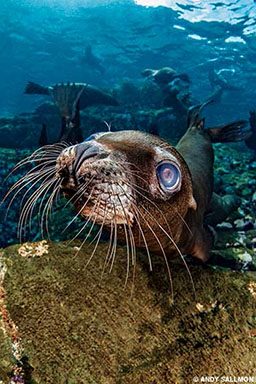Kneeling on the floor of the animal-care center surrounded by barking patients, I was reminded of veterinary school — with one major difference. The pens here were filled not with dogs but with pinnipeds. Dr. Richard Evans, the veterinarian for the Pacific Marine Mammal Center (PMMC) in Laguna Beach, Calif., knelt beside me and examined a 28-pound California sea lion nicknamed O’Brien. A local resident had discovered the exhausted and shivering young sea lion near the shoreline and had contacted the PMMC rescue team. The little pup was critically malnourished; extreme nutritional problems are difficult to overcome in such a young animal. It was unlikely O’Brien would survive.
A glance at the PMMC’s busy staff and full pens revealed the extent of the well-publicized crisis. Early in 2013, marine mammal rescue operations throughout Southern California began reporting record numbers of California sea lion strandings. The California Marine Mammal Stranding Network, for example, reported 293 strandings in Orange County between January 1 and March 31, 2013, compared with a total of 20 during the same period in 2012. Affected animals were almost exclusively pups born in 2012, and they were nearly always emaciated and dehydrated, many fatally so.
This was not news to avid Southern California divers, many of whom had witnessed exhausted pups hauling themselves onto dive-boat decks at sites miles from shore or watched lifeguards sadly remove dead pups from beaches. Nor was it surprising to coastal residents from San Diego to Santa Barbara; they had been inundated with broadcasts about homeowners discovering starving pups on their property.
Marine mammal organizations in the area were quickly overwhelmed. At the peak of the crisis, the PMMC housed an overwhelming 167 patients and had reached their absolute limit. The staff was regularly working 16-hour shifts, and volunteers from the U.S. Navy Marine Mammal Program were donating their time to help feed the recovering pups.

While it was clear to conservationists, government officials and residents that something abnormal was happening, the reasons for the situation were unclear. According to the website for the National Oceanic and Atmospheric Administration (NOAA) at the time of this writing, the reasons remain uncertain. No infectious or toxicologic (including radiologic) causes have been publicly identified, and no other marine mammal species appear to be affected.
Population increases in California sea lions (NOAA estimates a steady year-to-year increase of 5.4 percent) don’t seem to account for such a massive single-year increase in strandings. Although sea lion populations have experienced abrupt, precipitous declines in El Niño years, the 2013 incident did not correspond with a declared El Niño weather phenomenon. Still, the most obvious scapegoat is environmental factors. Food shortage seems likely to be a major component: A 39-year investigation by the Scripps Institute of Oceanography recently determined that there has been a substantial decrease in Southern California coastal fish numbers among both fished and nonfished species; the study concluded that an oceanographic climate alteration may be to blame.
A combination of factors could also be at play. Recent research examining Galapagos sea lions suggests that compared with pinnipeds in the wild, pinnipeds affected by human populations can exhibit a greater decline in body condition when they need to mount an immune response, a relationship that could quickly become extreme when fish are hard to come by.
Adding to the issue’s complexity is some residents’ view that simply investing time, money and effort into determining the cause of the stranding crisis can oppose natural selection. Others argue that human interference could have a negative impact on the food supply of sharks and other predators.
No matter the reason for the crisis or the “right” thing to do, the veterinarian in me felt a rush of joy when four months after my initial visit the PMMC invited me to witness a special event: O’Brien, the skinny pup who faced such a bleak outlook at his rescue, was ready to be released. Now weighing 86 pounds, he was not only eating well on his own, but also adroitly competing for fish. I watched in elated, hopeful silence as a volunteer raised the cage door and O’Brien headed for the surf — a fat, brown blur racing across the sand to dive into the Pacific.
© Alert Diver — Q4 Fall 2013